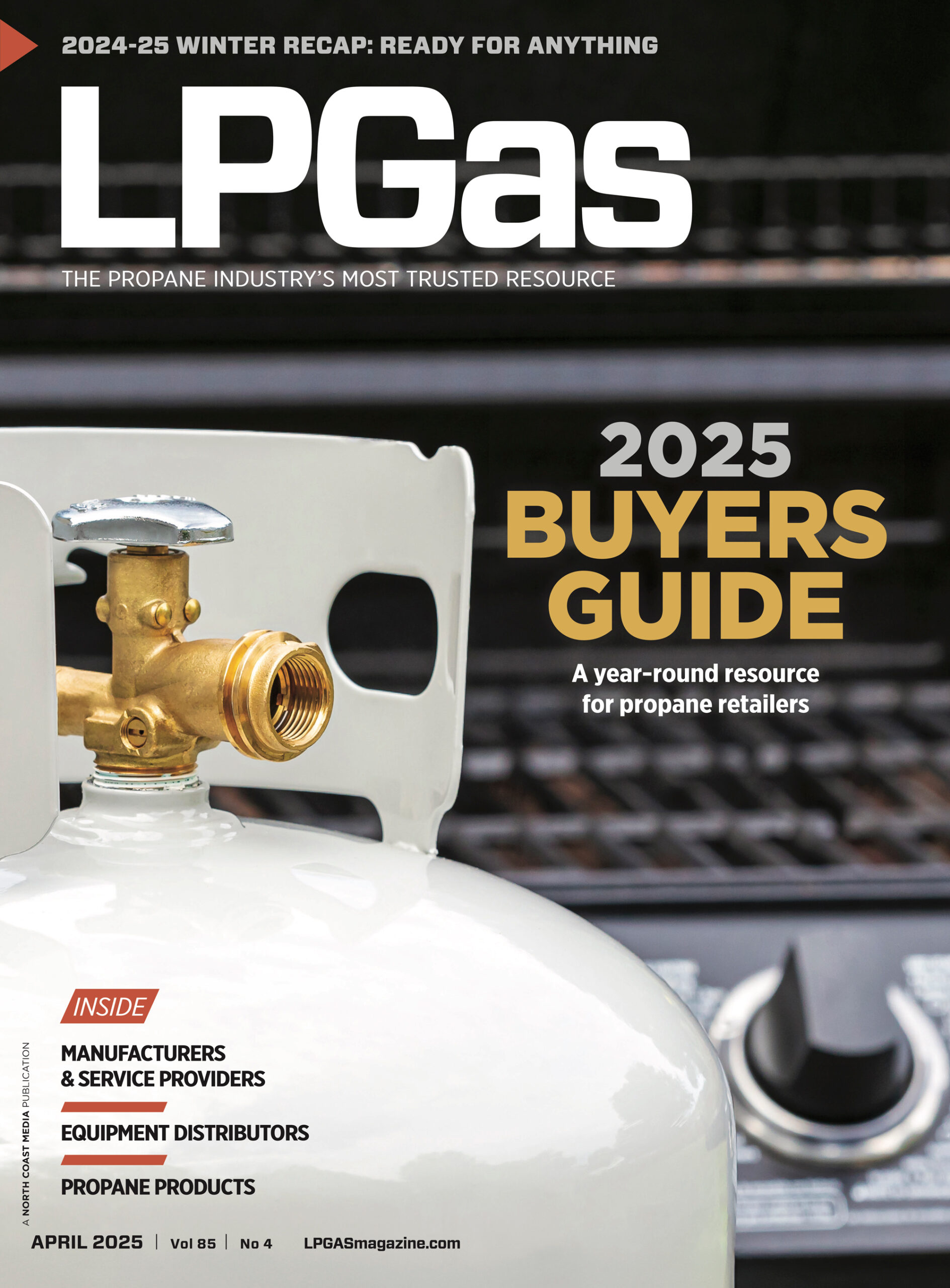Impact of last year’s winter hampering heating-season prep
 A key industry wholesaler reports that the amount of propane prebuys typically transacted by mid-August has been slashed in half – a management strategy that’s fraught with peril should a bitterly cold winter ensue.
A key industry wholesaler reports that the amount of propane prebuys typically transacted by mid-August has been slashed in half – a management strategy that’s fraught with peril should a bitterly cold winter ensue.
“People remember what happened last year, and this summer they were still pulling their prebuy from last year,” says the supplier, requesting anonymity because of the sensitivity of the situation, “and they’re not in any mood to buy any prebuys now.”
“That’s playing Russian roulette this year,” says D.D. Alexander, president of Global Gas Inc. “You should buy what you sell and sell what you buy. If we’re selling prebuys to our customers, we cover it; we’re always covered. This is not the year for a retailer to not have a supply contract in place because of all the supply terminals that are no longer operating.”
“If you are a propane dealer, I would not be dilly-dallying around,” agrees Rusty Braziel, president of RBN Energy.
“I can’t see propane getting any cheaper than it is now,” says consultant Peter Fasullo at En*Vantage Inc. “If I were a marketer, I’d be locking in my prices right now.” He also emphasizes the wisdom of being ready for any number of unforeseen circumstances, such as a nasty hurricane wreaking havoc with the oh-so-important infrastructural apparatus along the Gulf Coast.
“People are being lulled into a false sense of security,” says consultant Ron Gist, a director at IHS Inc. subsidiary Purvin & Gertz. “Last year I was warning people that I was worried about the inventory situation because we were exporting boatloads of propane. I was accurate at that time, but then Mother Nature threw everyone a curveball with one of the warmest winters on record.
“Going into next year, it’s all going to depend on the severity of the winter,” Gist adds. “The jury is still out on what the weather is going to be. I don’t even believe the weather forecast for tomorrow – let alone six months from now. I’d start filling my tanks right now because when you get into January and February there’s some potential that it could start getting tight.”
Supplies may be high and prices low in the months before the snow flies, but the possibility of troublesome situations with refineries, pipelines and import terminals needs to be taken into account, according to Gist.
“You have three supply sources that are dicey,” he says. “There’s always something. The country as a whole may be fine, but the Upper Atlantic and New England areas can always have problems.”
“A lot of retailers suffered from last winter’s lack of demand. Early summer prices were low, and no one felt pressure to do any price protection through prebuys or financial tools. Supply is perceived to be robust because of the shale production. There are pockets of real cheap supply,” says consultant Dale Delay, president of Cost Management Solutions. “Fundamentally the market is well supplied, and retailers are willing to bet on lower prices heading into winter. Prices are off their early summer lows but substantially less than last winter’s numbers.”
Logistical challenges
The Propane Gas Association of New England (PGANE) is pushing its members to fill their customers’ tanks along with their own while the propane remains available.
There are a lot of variables with the supply picture, says PGANE President Joe Rose. Inergy had yet to secure permits for a storage facility in New York’s Finger Lakes region that could hold about 85 million gallons of propane.
Rose reports also that transloading is becoming more popular, in which railcars utilize portable compressors that push the gas directly into transports without it first being placed into fixed storage.
“With the world economy being what it is, our import terminals are going to be irrelevant,” Rose says.
On average, these import terminals supply 200 to 300 million gallons of propane to the region (about 40 percent to 50 percent of the total volume), but Rose estimates that less than 50 million gallons will be coming from those terminals this winter.
“The difference [of 150 to 250 million gallons] will be made up by new rail facilities,” he says. “That’s a lot of rail, and they are unproven, untested and, quite frankly, under construction. If we get any kind of weather, we’re going to be in for a rocky road.”
“The railcar situation is really tight, from what I understand,” says Gist, citing heightened demand from fracking and other oil field plays, especially in connection with the Bakken oil sites in North Dakota. “There aren’t that many pipelines up there, so they’re using railcars and it’s tightened up the railcar fleet.
“People are ordering more railcars [to be built], but you can’t just buy them off the shelf,” says Gist, referring to the time it takes to fabricate the units.
Transport trucks could also be in short supply.
“There are areas of the country we’re monitoring closely, areas where there is robust oil and gas drilling that places a premium on trucking capacity of all kinds,” says Jimmy Ainsworth, vice president of transportation for Ferrell North America. “The potential impact this drilling has on transportation is well documented in the trucking industry.
“Our approach at Ferrellgas is to continue to leverage our robust internal transport fleet and continue to build relationships with our more than 100 common carrier partners around the country. We’re as confident as ever in our ability to service our own locations, as well as our many wholesale customers this coming winter.”
“In the past, we’ve been able to pull trucks from the Midwest and move them to the Northeast or wherever they’re needed,” says Alexander at Global Gas. But with ongoing regional pricing differentials of up to 30 cents per gallon, “people are trucking propane longer distances, and it takes more trucks – that’s a scary thing; where are you going to get the trucks? It could lead to a very tricky winter.”
“Instead of driving 50 miles, they’re driving 300 miles,” says consultant Marty Lerum at Propane Resources. “You’ll drive a long way in a truck for 30 cents a gallon.”
Tighter pipelines
Pipelines are being squeezed as well, according to Alexander. “In the Northeast, they’re limiting the amount of gas that shippers can put in. You can put in only what you take out every day, and it’s limited to that 24-hour day,” she says. “In the past, we had a certain amount of inventory that we could keep in the pipeline.”
Should temperatures take a precipitous tumble this winter, Alexander says, “you’ll still be able to get propane, but at what price?” A firm that’s flush with supply could end up cornering the market and driving up the cost when the gas is needed the most.
“If one guy is holding all the gold, the prices can spike,” Alexander says. “You should have a volume supply contract, and you want to lock in the price if you’ve sold that gas to your customer. We typically don’t buy product based on weather forecasts. We buy based on how much product is contracted with our customers.”
“Propane prices will be getting stronger relative to the price of crude oil going into the winter,” says RBN’s Braziel, echoing Alexander’s urgings for retailers to actively market their propane offerings, obtain supply and secure the pricing.
Braziel observes that unpredictable weather conditions will ultimately dictate just how the flow will go heading into the winter season, particularly in the LPG hotbed of the Northeast.
“You tell me how cold it’s going to be and I’ll tell you what problems you’ll have in New England,” he says. “If we have a winter like we did last year, we won’t have any problems with logistics. There will be problems, but logistics won’t be among them.”
Some marketers have had a tough time weathering the economic aftermath of last year’s mild winter, with business off by an average of 25 percent, reports Lerum at Propane Resources.
“There are a lot of retailers who didn’t make any money last year, so they’re not doing as many things because they don’t have the money to spend,” he says.
Plans to purchase new bobtails, tanks and other improvements have been put on hold, and prebuys curtailed. Valued employees have been laid off or hours cut. “Some retailers are going to a four-day workweek to save money,” Lerum says.
Lamenting the propensity of industry participants to be far more focused on operations rather than marketing, Lerum continues to highlight the security that comes with selling budget plans to the customer base.
“Even if they didn’t make as much money last year, they still have cash flow,” he says, extolling the benefits of collecting monthly payments no matter the weather. “Budget plans have a very positive impact on cash flow.”
Autogas and appliances are among the load-enhancing alternatives that can be added to marketing initiatives, according to Lerum, who adds that having a qualified and sales-minded LPG appliance technician is crucial for reaching homeowners within a service territory.
















